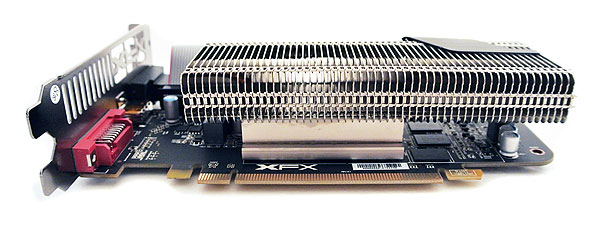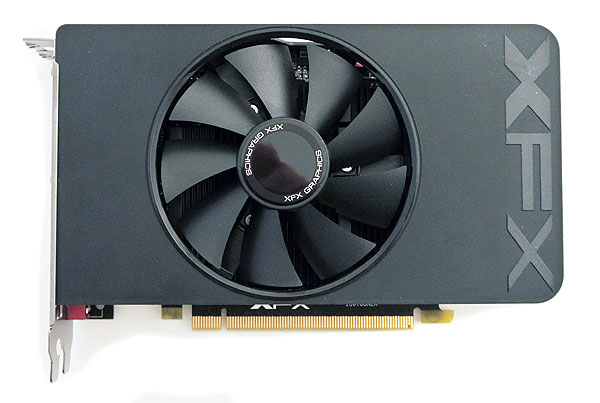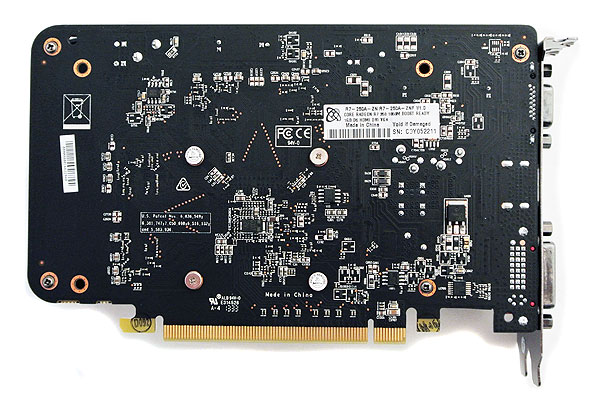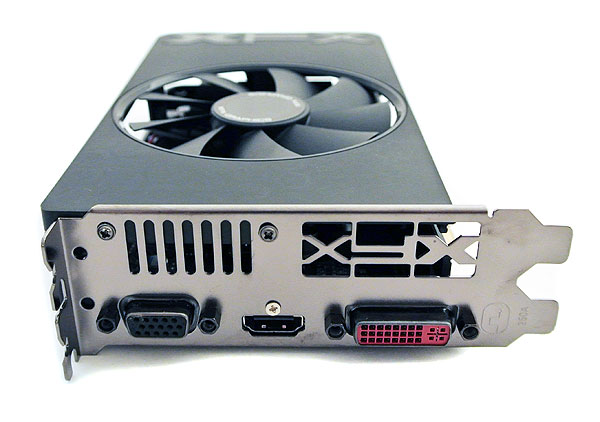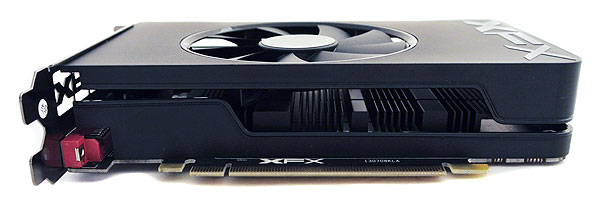Radeon R7 240 And 250: Our Sub-$100 Gaming Card Round-Up
Now that AMD's Radeon R7 240 and 250 are here, we want to know a little more about what the sub-$100 market looks like. Can the latest Oland-based boards serve up playable performance in the latest titles, or are there other hidden gems to discover?
Introducing The Radeon R7 240 And 250
While the Radeon R7 240 and 250 are new in the retail space, they've been available to OEMs for a year as the Radeon HD 8570 and 8670, respectively. Both cards are based on the Oland GPU. Although the graphics processor does support higher clock rates through PowerTune with Boost, it's considered a first-gen GCN-based GPU and does not offer any of the features introduced with the Radeon R9 290-series cards, such as TrueAudio, precision improvements to the native LOG and EXP operations, or optimizations to the Masked Quad Sum of Absolute Difference (MQSAD).
As the Radeon R7 240, AMD's Oland Pro is limited to five of the GPU's six available Compute Units, each with 64 shaders and four texture units. Do the math and you get 320 total shaders and 20 TMUs. Two ROP partitions are capable of processing eight operations per cycle. Additionally, a pair of 64-bit dual-channel memory controllers yield a 128-bit aggregate pathway. This is the smallest we've ever seen Graphics Core Next scaled down, so I'm personally curious to see how it'll compare to previous-gen parts like the Radeon HD 6670 DDR3 with 480 VLIW5 shaders.
In fact, comparing the Radeon R7 240's 730 MHz base and 780 MHz peak clock rates to the Radeon HD 6670 DDR3's 800 MHz frequency should shed some light on how much more (or less) efficient GCN is next to VLIW5 (which we already know was not as efficient as VLIW4). A 128-bit memory bus laden with 900 MHz DDR3 memory is used on both cards, so memory bandwidth is identical.
The Radeon R7 250 comes equipped with an uncut version of the GPU, called Oland XT. All six of its Compute Units are operational, exposing 384 shaders and 24 TMUs. The back-end is unchanged; you still get two ROP partitions and a 128-bit memory interface. So, overall, there's not a ton of difference between the two GPUs. The Radeon R7 250 has other advantages, though. Its core operates at 1000 MHz and can accelerate up to 1050 MHz under the right thermal conditions. Manufacturers can also choose to arm it with GDDR5 memory. I'd even go so far as to say avoid models with DDR3, since they sell for close to the same price.
Perhaps you noticed that the Radeon R7 250 sounds a lot like the Radeon HD 7730, a card based on a cut-down Bonaire GPU with the same number of CUs, shaders, and ROP partitions. The Radeon HD 7730 runs at 800 MHz though, and the GDDR5-based version sports memory operating 25 MHz slower. We're including it in our benchmarks for comparison.
XFX Radeon R7 240 Core Edition
XFX provided two Radeon R7 240 samples. Both are able to accelerate up to 780 MHz under the right conditions and feature 2 GB of 800 MHz DDR3. Also, they're based on the same half-height 7" x 2.75" PCB. The only functional difference between them concerns cooling; one model is actively cooled by a 50 mm fan, while the other is passively-cooled.
Interestingly, XFX's memory clock is 100 MHz under AMD's 900 MHz reference spec. We increased this using Overdrive, so our benchmark results reflect AMD's proposed performance levels, rather than XFX's.
Get Tom's Hardware's best news and in-depth reviews, straight to your inbox.
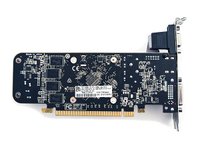

Not surprisingly, the cards are similar around back. They employ the same Hynix H5TQ2G63BFR memory packages and rounded PCB edges.
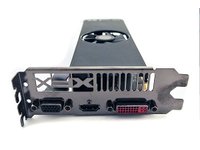

XFX equips both cards with dual-link DVI, HDMI, and VGA outputs.
The Radeon R7 240 has a relatively low 30 W TDP, so the power it needs is easily delivered by a PCI Express slot.
It would have been possible to build these cards in a single-slot form factor. However, XFX chose a dual-slot design for improved cooling.
This class of Radeon card doesn't come equipped with bridge connectors for CrossFire (nor does it enjoy the benefit of AMD's integrated XDMA engine). Instead, it can be linked to a second board using the PCI Express bus.
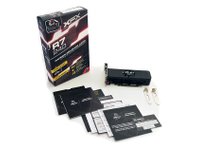

XFX bundles its cards with warranty information, a quick install guide, a driver install guide, a graphics card and peripheral pamphlet, a power supply pamphlet, and support information. They also come with a driver CD and half-height output bezels.
XFX Radeon R7 250 Core Edition
The XFX Radeon R7 250 Core Edition adheres to AMD's reference peak clock rate of 1050 MHz, complemented by 1 GB of 1150 MHz GDDR5 on a full-height 7" x 4.5" PCB. The black acrylic Ghost cooler has an understated style that's not flashy and is still classy-looking.
Like the Radeon R7 240 cards, this one's PCB also has rounded edges.
The display outputs are similar, too. You get dual-link DVI, HDMI, and VGA connectors.
XFX's Ghost cooler uses an 85 mm fan to contend with the GPU's 65 W TDP. There's a space between the fan bezel and card itself for airflow, and the large heat sink covers both the graphics processor and memory packages. This card also lacks a physical CrossFire connector, just like AMD's Radeon HD 7750. Two-card configurations communicate over PCI Express.
The same support documentation is included: there's a warranty information card, a quick install guide, a driver install guide, a graphics card and peripheral pamphlet, a power supply pamphlet, and support information. A driver CD is also included, but there's no half-height bezel option for this full-sized product.
Current page: Introducing The Radeon R7 240 And 250
Prev Page The Sub-$100 Graphics Card Market Next Page Test Setup And BenchmarksDon Woligroski was a former senior hardware editor for Tom's Hardware. He has covered a wide range of PC hardware topics, including CPUs, GPUs, system building, and emerging technologies.
-
Hazly1979 This card is slower than HD 7750AMD is playing now for sub par $100Reply
Watch the language - G -
emad_ramlawi No need to read the review, those parts are HD 7750 or the new Nvidia GTX 750 for the WINReply
Watch the language - G -
blackmagnum Just buy a bigger PSU and be done with these poor performance-for-the-dollar/watt cards.Reply -
tridon These discrete cards that squeeze frames out with very little power drain are great. I recently bought one such cheap AMD-card for my fiancée when she wanted to play Guild Wars 2 with me. Having an aging low cost workstation with a weak power supply "Made in Hell", cards like these were the only option. At least without having to upgrade and tweak other parts of the PC. (Yes I'm lazy ).Don Woligroski: For the few(?) that are in the same situation as me it would be great to se an efficiency chart. Like average frames pr. average watt usage through a benchmark, or something in that vein.Reply -
Martell1977 My brother has a HP s3500f slimline computer that I thought the R7 240 might work well in (at least better than the Geforce 6150se it has now). Problem is he has a 250w PSU, all the R7 240's list 400w minimum and it seems the only place to get one under $75 is eBay($43, new). 400w seems awfully high for such a low end card...Reply -
cleeve Reply12559832 said:My brother has a HP s3500f slimline computer that I thought the R7 240 might work well in (at least better than the Geforce 6150se it has now). Problem is he has a 250w PSU, all the R7 240's list 400w minimum and it seems the only place to get one under $75 is eBay($43, new). 400w seems awfully high for such a low end card...
A 400W is overkill if you're running a power-efficient CPU.
Look at the results, the most this system puilled with the R7 240 is 122 Watts under load. That's the whole system, with an overclocked Core i5-2500K!
A good 250W PSU should be fine. AMD is kind of recommending overkill here, but they do that to protect people from poor quality PSUs. A 250W HP shouldn't be a problem as long as the platform isn't power hungry.
-
cats_Paw Cleeve.... not true:http://www.guru3d.com/articles_pages/amd_radeon_hd_7750_and_7770_review,7.htmlA stressed 7770 Requires at least a 400W good PSU (Note that 400W DOES NOT mean 400W on the 12V rail, but 400W in total. If you do that math in a 250W supply you get a lot less power on the 12V rail, who knows maybe 170... Also remmber that the GPU needs a fixed amount of power in a defined amount of cables. This means that if the PSU is not good, it wont be able to juice the GPU well enought).Reply -
Sakkura In Metro: Last Light, the GT 640 gets exactly the same FPS and frame time variance at both 720p and 1080p. It looks like you accidentally input the data from one benchmark run in both places.Reply
*EDIT BY EDITOR*
You're absolutely right! We fixed the charts, thanks for catching that! -
Sakkura Reply
A good 250W power supply will have 18-20 amps on the 12V rail, which is fine for the R7 240.12560307 said:Cleeve.... not true:http://www.guru3d.com/articles_pages/amd_radeon_hd_7750_and_7770_review,7.htmlA stressed 7770 Requires at least a 400W good PSU (Note that 400W DOES NOT mean 400W on the 12V rail, but 400W in total. If you do that math in a 250W supply you get a lot less power on the 12V rail, who knows maybe 170... Also remmber that the GPU needs a fixed amount of power in a defined amount of cables. This means that if the PSU is not good, it wont be able to juice the GPU well enought).
I don't know why you bring up the 7770, it clearly draws a lot more power than the R7 240. -
InvalidError Where do you get that 400W figure from that Guru3D article? The highest measured figure in there says: "System Wattage with GPU in FULL Stress = 231W" and further down they say they estimate the board's power to max out at ~86W which is just above 7A.That would be power measured at the wall which includes PSU losses... and their test system includes water pump for their OC'd i7-965, cold-cathode lighting and a bunch of other unnecessary stuff most low-end systems would not have that brings their idle power up to a whopping 155W instead of the 50-80W range for typical for current Intel-based mainstream setups.Reply




